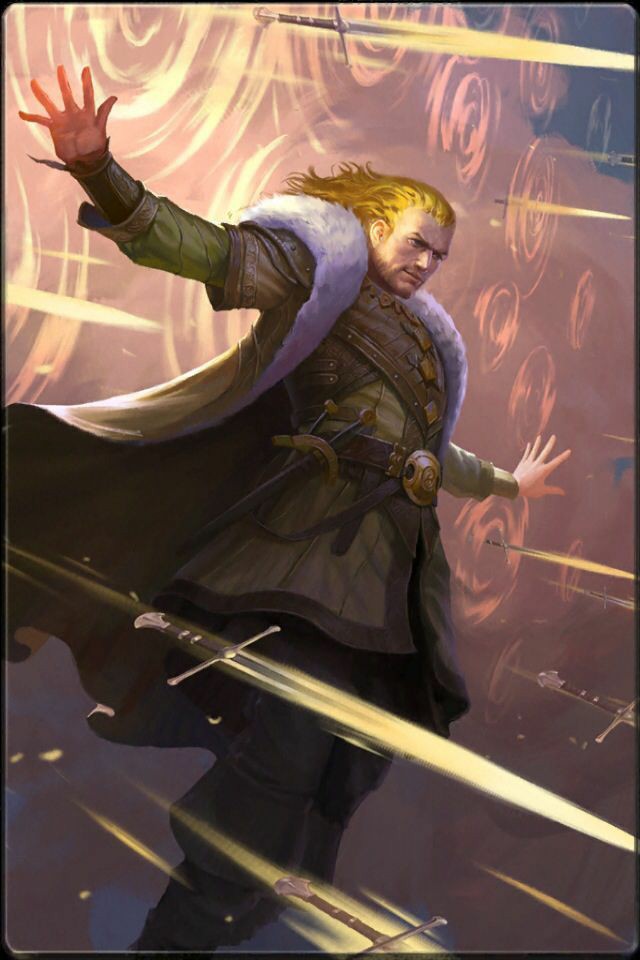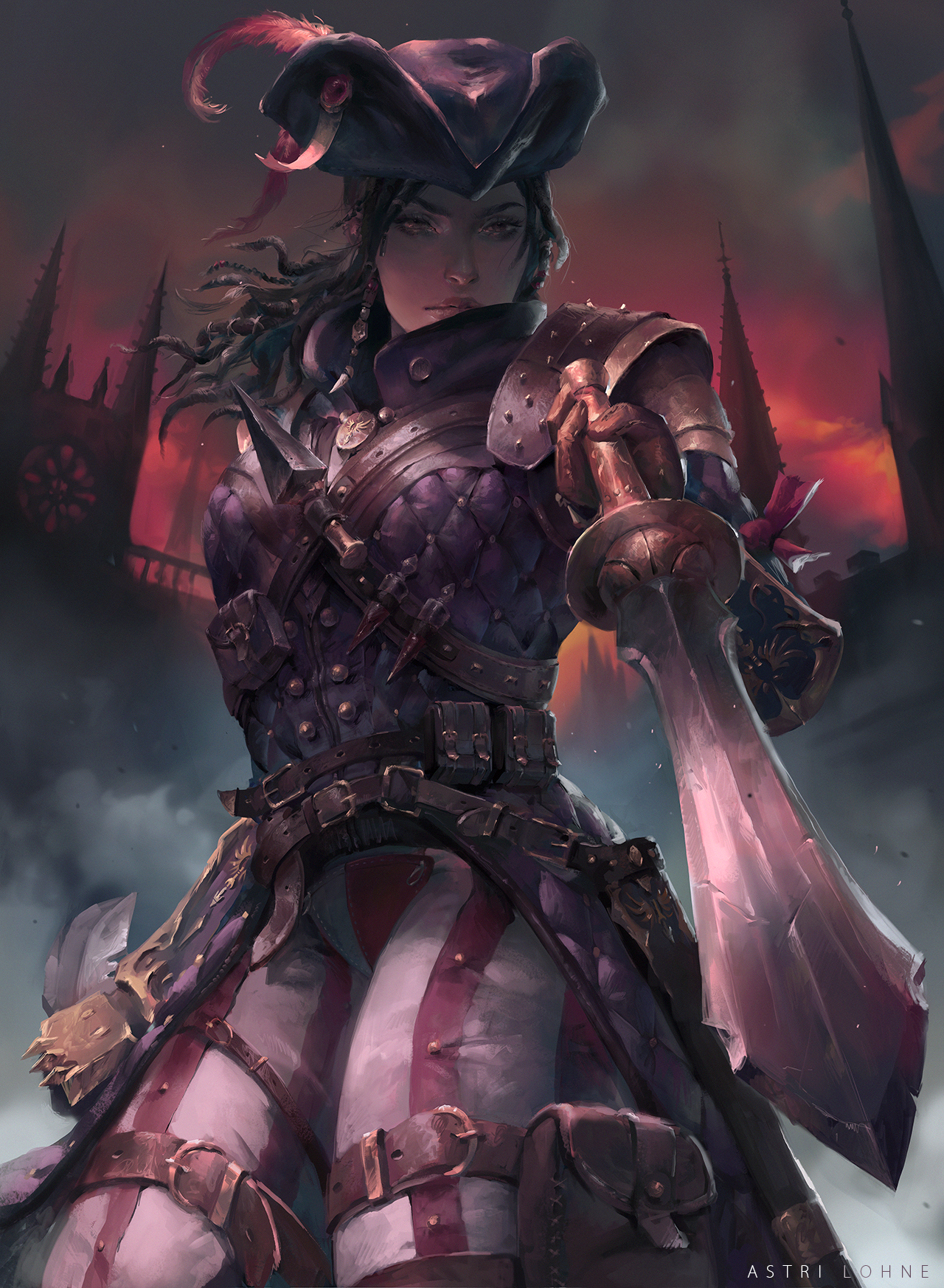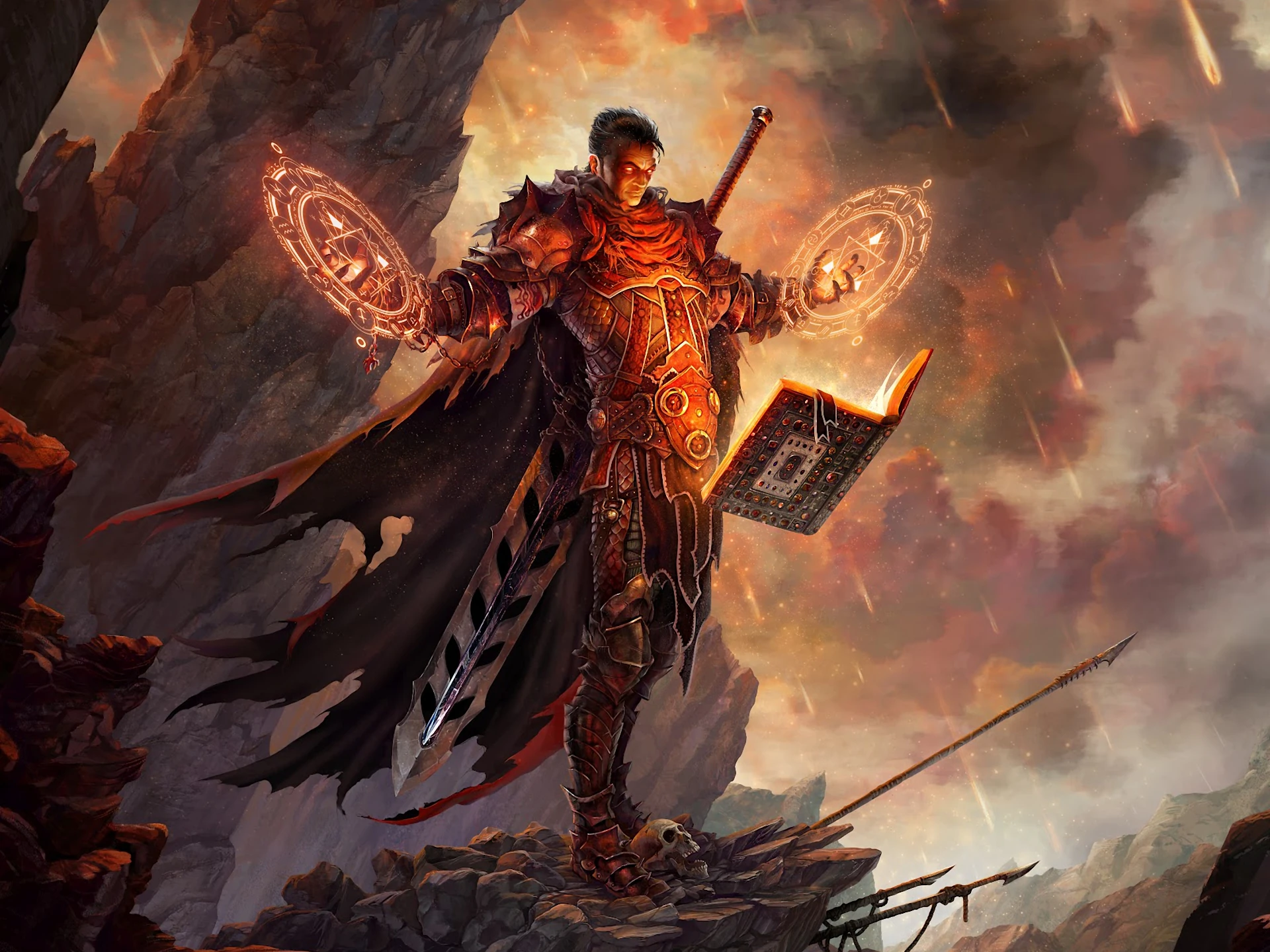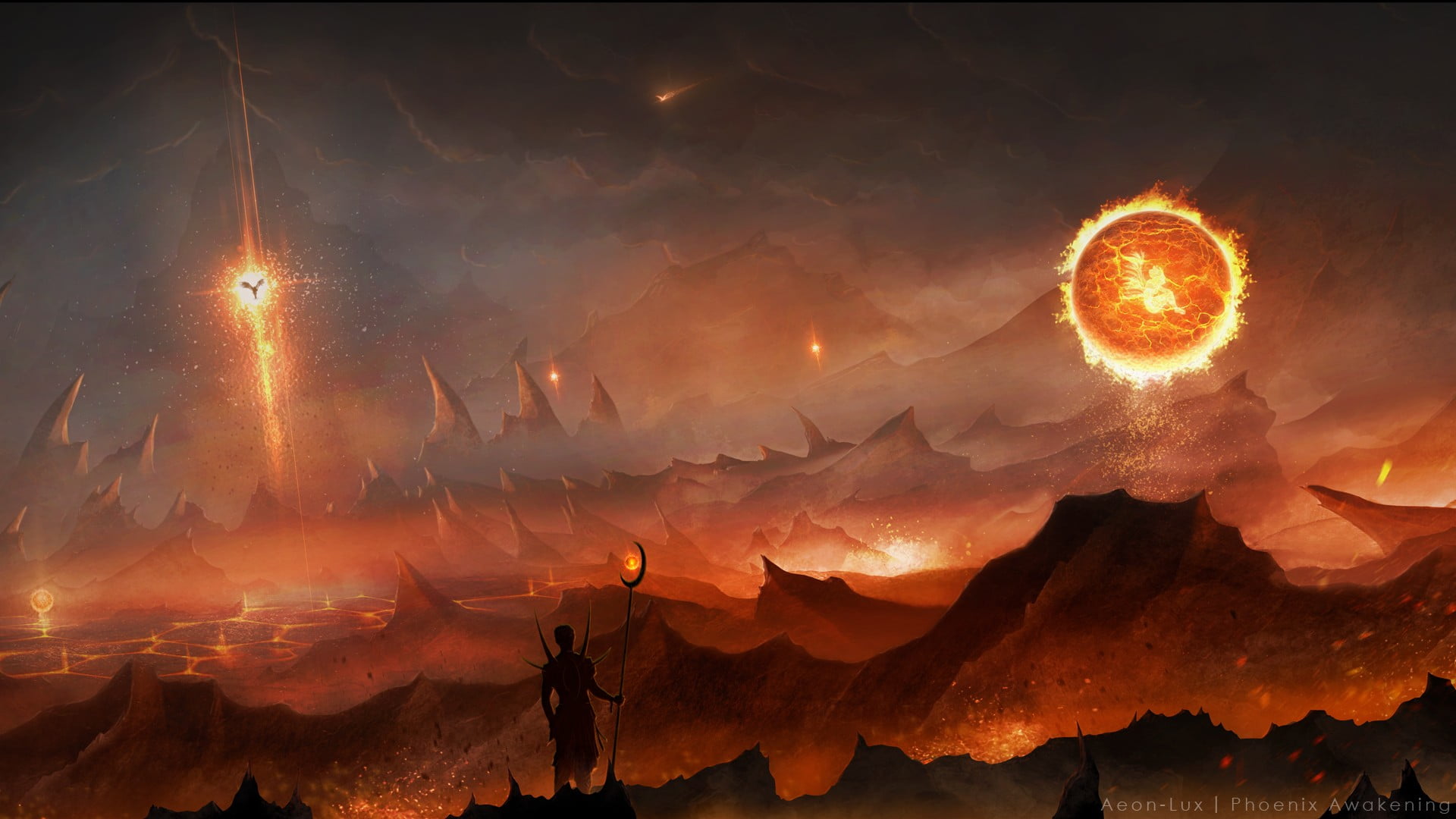
Magus
A dhampir is seen stalking the city streets at night, searching for clues leading to a death cult that's been terrorizing the area. His eyes flash as the runes underneath his eyelids flood with magic, causing a trail of blood red smoke to appear in his sight, leading to a clue.
During a battle, an aasimar unloads a barrage of arrows at a black dragon as it readies a corrosive blast from its maw. Just before it unleashes its breath she points in the dragon's direction and a blast of flame chars the inside of the dragon's mouth, finally finishing it off.
A human tries for over the hundredth time in that day to inscribe a rune upon their blade. As their mentor watches patiently, the human manages to inscribe the rune almost perfectly, and the blade begins to float and sway according to its master's whim.
Enforcers, soldiers, and protectors all, every magus, no matter their praxis is a master of combining the martial and arcane arts, and can become a whirlwind of blade and spell when necessary.
Enforcers of the Weave
While every magus praxis is different in its own way, all share a goal in protecting the balance of the magical weave that permeates the world. By choosing their praxis, a magus decides what magical "truth" to pursue, and how they will go about defending that truth to the death, through words or through combat.
Their training allows them to more easily resist the magic used by other spellcasters and magical creatures, and have abilities and skills to help them track down and destroy their quarry.
Exceptionally Trained
Usually trained in magical colleges or conclaves by other magi, some arcane colleges with no magi mentors available will hire martial teachers to train new willing apprentices in the way of the combat while continuing their arcane curriculum simultaneously.
Magi are highly sought after for work after they graduate and finish their training. Whether it's be to be a personal bodyguard to a noble, be a soldier in a great army, or to hunt magic users that abuse their power.
Seekers of Knowledge
While a magus is trained in the ways of blade and spell, they also have to train their minds to absorb and retain all the knowledge required to be a magus.
As they go about their travels, many a magus will go out of their way to explore anything from old tombs to city libraries to find secret knowledge. They usually seek knowledge not only for their own benefit, but to send back to their college or conclave, adding it to their hoards of information.
In fact many magi, after finishing their training, are given a choice to go their own way, or to work for their college, sent on quests for knowledge to add to the college archives.
Vagabond Magi
Not all magi are formally trained, some are even drop-outs from their magical college, and some may simply be folk who are equally proficient with a blade and magic. Learning how to properly channel arcane energy through a weapon can be a difficult task for one who wasn't trained by a professional magus instructor, but it is not unheard of.
While many professional magus instructors will look down on these "vagabond magi", they are nonetheless impressive specimens, usually inventing their own style of magi-combat or even their own praxis, their own school. Many even go on to form their own schools to teach their style of fighting to other willing apprentices, forming conclaves that many professional magi will turn their nose up at.
Quick build
You can make a magus quickly by following these suggestions.
Firstly, make Strength your highest stat, followed by Intelligence (Some magi who use ranged weapons such as bows or crossbows make Dexterity their highest, rather than Strength). Secondly, choose the sage background. Third, choose the create bonfire, and dancing lights cantrips.




Magus
—Spell Slots per Spell Level—
| Level | Proficiency Bonus | Features | Cantrips Known | 1st | 2nd | 3rd | 4th | 5th |
|---|---|---|---|---|---|---|---|---|
| 1st | +2 | Flash Ward, Cantrips, Spell Attunement | 2 | – | – | – | – | – |
| 2nd | +2 | Spellcasting, Fighting Style | 2 | 2 | – | – | – | – |
| 3rd | +2 | Magi Praxis, Mage Sight | 2 | 3 | – | – | – | – |
| 4th | +2 | Ability Score Improvement | 2 | 3 | – | – | – | – |
| 5th | +3 | Extra Attack | 2 | 4 | 2 | – | – | – |
| 6th | +3 | Praxis Features | 2 | 4 | 2 | – | – | – |
| 7th | +3 | Arcane Bulwark | 2 | 4 | 3 | – | – | – |
| 8th | +3 | Ability Score Improvement | 2 | 4 | 3 | – | – | – |
| 9th | +4 | – | 2 | 4 | 3 | 2 | – | – |
| 10th | +4 | Spell Snatch | 3 | 4 | 3 | 2 | – | – |
| 11th | +4 | Praxis Features | 3 | 4 | 3 | 3 | – | – |
| 12th | +4 | Ability Score Improvement | 3 | 4 | 3 | 3 | – | – |
| 13th | +5 | – | 3 | 4 | 3 | 3 | 1 | – |
| 14th | +5 | Spell Rebuke, Mage Sight Improvement | 3 | 4 | 3 | 3 | 1 | – |
| 15th | +5 | Praxis Features | 4 | 4 | 3 | 3 | 2 | – |
| 16th | +5 | Ability Score Improvement | 4 | 4 | 3 | 3 | 2 | – |
| 17th | +6 | – | 4 | 4 | 3 | 3 | 3 | 1 |
| 18th | +6 | Iron Focus | 4 | 4 | 3 | 3 | 3 | 1 |
| 19th | +6 | Ability Score Improvement | 4 | 4 | 3 | 3 | 3 | 2 |
| 20th | +6 | Magi Empowerment | 4 | 4 | 3 | 3 | 3 | 2 |
Class Features
As a magus, you gain the following class features.
Hit Points
- Hit Dice: 1d8 per magus level
- Hit Points at 1st Level: 8 + your Constitution modifier
- Hit Points at Higher Levels: 1d8 (or 5) + your Constitution modifier per magus level after 1st
Proficiencies
- Armor: Light armor, medium armor, shields
- Weapons: Simple weapons, martial weapons
- Tools: None
- Saving Throws: Constitution, Intelligence
- Skills: Choose two from Arcana, History, Insight, Investigation, or Religion
Equipment
You start with the following equipment, in addition to the equipment granted by your background:
- (a) scale mail or (b) leather armor, and a simple or martial ranged weapon with 20 pieces of ammunition
- (a) a martial weapon and a shield or (b) two martial weapons
- (a) an explorer's pack or (b) a scholar's pack
- any simple weapon
Alternatively, you may start with 4d4 × 10 gp to buy your own equipment.





Flash Ward
At 1st level, you gain the ability to create magical force fields to defend yourself and others.
As a reaction when you or an allied target you can see within 30 feet of you takes damage, you can form an arcane shield around the target, reducing the damage taken by 1d6 + your Intelligence modifier.
You can use this feature a number of times equal to your proficiency bonus, and you regain any expended uses when you finish a short or long rest.
Cantrips
Also at 1st level, can learn two cantrips of your choice from the magus spell list shown at the end of this document. At higher levels, you can learn additional cantrips of your choice, as shown in the Cantrips Known column of the Magus table.
Spellcasting Ability
Intelligence is your spellcasting ability for your magus cantrips, and later on for your spells, since your magic draws on your knowledge of arcane magic. You use your Intelligence whenever a cantrip refers to your spellcasting ability. In addition, you use your Intelligence modifier when setting the saving throw DC for an artificer cantrip you cast and when making an attack roll with one.
Spell Save DC
Spell attack modifier
Spell Attunement
At 1st level, you learn to infuse yourself with magic when you are focusing on your spells. When you begin concentrating on a magus spell, you gain the following benefits:
- You gain a bonus to your AC equal to half the spell's level (rounded up, minimum of 1).
- Your weapon attacks count as magical for the purpose of overcoming resistance and immunity to nonmagical attacks and damage.
- When you cast a cantrip with a casting time of one action (including the spell you begin concentrating on), or use your action to trigger or maintain a spell's effect, you can use your bonus action to make one weapon attack.
Before you make an attack on a creature with a weapon attack while under the effect of your Spell Attunement feature, you can choose to end concentration on your spell to infuse your weapon with arcane energy. If the attack hits, you deal extra force damage to the target, in addition to the weapon's damage.
The extra damage is 2d4 if the spell was a cantrip. If the spell was using a 1st level spell slot, the damage is 3d4, plus 1d4 for each spell level higher than 1st, to a maximum of 7d4. If the creature is concentrating on a spell, the DC for the saving throw made to maintain concentration on it against this instance of damage increases by a number equal to the level of the spell you were concentrating on (minimum of 1).
Spellcasting
When you reach 2nd level, you have learned to inscribe spells into your weapons.
Lexicon You have a weapon inscribed with 3 1st-level magus spells of your choice. This weapon is your lexicon, the repository of the magus spells you know, except your cantrips, which are fixed in your mind.
Copying a Spell into your Lexicon. When you find a magus spell of 1st level or higher, you can add it to your lexicon if it is of a spell level you can prepare and if you can spare the time to decipher and copy it.
Inscribing a spell into your lexicon involves reproducing the basic form of the spell, then deciphering the system of notation used by whom had wrote it. You must practice the spell until you understand the sounds or gestures required, then transcribe it into your lexicon using your own notation.
For each level of the spell, the process takes 1 hour, which you must spend in uninterrupted concentration.
Replacing the Lexicon. You can copy a spell from your own lexicon into another. This is just like copying a new spell into your lexicon, but faster, as you understand your own notation and already know how to cast the spell. You need spend only 30 minutes for each level of the copied spell.
If you lose your lexicon, you can use the same procedure to transcribe the spells that you have prepared into a new lexicon. Filling out the remainder of your lexicon requires you to find new spells to do so, as normal. It's recommended you take the time to create a backup lexicon.
Spellcasting Focus You can use any weapon that you are proficient with as a spellcasting focus for your magus spells.
Learning Spells of 1st Level and Higher Each time you gain a magus level, you can add one magus spell of your choice to your lexicon. Each of these spells must be of a level for which you have spell slots, as shown on the Magus table. On your adventures, you might find other spells that you can add to your lexicon.
Preparing and Casting Spells The magus table shows how many spell slots you have to cast your magus spells of 1st level and higher. To cast one of these spells, you must expend a slot of the spell's level or higher. You regain all expended spell slots when you finish a long rest.
You prepare the list of magus spells that are available for you to cast. To do so, choose a number of magus spells from your lexicon equal to your Intelligence modifier + half of your magus level (minimum of one spell). The spells must be of a level for which you have spell slots.
For example, if you're a 5th-level magus, you have four 1st-level and two 2nd-level spell slots. With an Intelligence of 16, your list of prepared spells can include six spells of 1st or 2nd level, in any combination, chosen from your lexicon. If you prepare the 1st-level spell thunderwave, you can cast it using a 1st-level or a 2nd-level slot. Casting the spell doesn't remove it from your list of prepared spells.
You can change your list of prepared spells when you finish a long rest. Preparing a new list of magus spells requires time spent studying your lexicon: at least 1 minute per spell level for each spell on your list.
The Lexicon's Appearance Magi have as many ways to inscribe their lexicon as there are praxes. Some may have invented their own runic alphabet, using meticulous placement of runes on the blade's surface.
Fighting Style
At 2nd Level, you adopt a style of fighting as your specialty. Choose one of the following options. You can’t take a Fighting Style option more than once, even if you later get to choose again.
Archery
You gain a +2 bonus to attack rolls you make with ranged weapons.
Dueling
When you are wielding a melee weapon in one hand and no other weapons, you gain a +2 bonus to damage rolls with that weapon.
Great Weapon Fighting
When you roll a 1 or 2 on a damage die for an Attack you make with a melee weapon that you are wielding with two hands, you can reroll the die and must use the new roll. The weapon must have the Two-Handed or Versatile property for you to gain this benefit.
Melee CastingNew
Being within 5 feet of a hostile creature doesn't impose disadvantage on your ranged spell attack rolls.
Two-Weapon Fighting
When you engage in two-weapon fighting, you can add your ability modifier to the damage of the second Attack.
Magi Praxis
At 3rd level, you have completed the basic training every magus goes through, and mastered the necessary practices. You are now prepared to choose an axiom to pursue, defining your fighting style and ideology.
Choose from the Elemental Heart Praxis, the Flying Steel Praxis, the Witch Hunter Praxis, the Light Bender Praxis, the Spirit Caller Praxis, the Scarlet Warden Praxis, or the Dark Magus.
Your choice grants you features at 3rd level, and again at 6th, 11th, and 15th. Those features include discipline spells.
Praxis Spells
Each axiom has a list of spells—its praxis spells—that you gain at the magus levels noted in the axiom description. Once you gain a praxis spell, you always have it prepared, and it doesn't count against the number of spells you can prepare each day.
If you have a praxis spell that doesn't appear on the magus spell list, the spell is nonetheless a magus spell for you.
Mage Sight
At 3rd level you use a combination of training and magic to find and hunt down magic users and magical objects. As an action, you can cast the detect magic spell, without expending a spell slot. When you cast detect magic in this way, you can also tell if a creature has any class levels in a class with the Spellcasting or Pact Magic feature. Or if a creature has the Innate Spellcasting feature. However, you cannot discern between them.
You can use this feature a number of times equal to your Intelligence modifier (minimum of 1), and regain all uses on a long rest.
At 14th level when you cast detect magic in this way, you can see the true form of any creature, or object that's concealed by illusion magic, and you can also tell what level spells they can cast up to (if any) while the creature is within range of the spell.
Extra Attack
Beginning at 5th level, you can attack twice, instead of once, whenever you take the Attack action on your turn.
Arcane Bulwark
At 7th level, you learn to protect yourself with a layer of arcane shielding to protect you from spells while focusing.
You have advantage on saving throws against spells of equal or lower level than a spell you are concentrating on.
At 14th level, you have advantage on all saving throws against spells or magical effects, while concentrating.
Spell Snatch
At 10th level, when you see or hear a creature cast a spell with verbal, or somatic components that has a casting time of 1 action, a bonus action, or a reaction within 60 feet of you, you can use your reaction to emulate its motions and words.
For the next minute, or until you lose concentration(as if concentrating on a spell) you can cast the spell using a spell slot. Spells cast with this feature count as magus spells. This feature counts as concentrating on a spell for the purposes of your Spell Attunement feature. You can choose to cast the spell immediately as part of the same reaction, or you can cast it at any time for the duration.
Spell Rebuke
At 14th level when you use your Flash Ward on yourself or an allied creature, you can cast a cantrip that targets only one creature against the creature that damaged the target of your Flash Ward, as a part of that reaction.
Iron Focus
At 18th level while you are concentrating on a spell, your concentration can't be broken unless you choose for it to.
Magi Empowerment
At 20th level you have become a master of blade and spell. When you begin concentrating on a spell of 1st level or higher, you can empower yourself in one of two ways:
- You gain resistance to bludgeoning, piercing and slashing damage.
- You gain a bonus to your saving throws equal to your Intelligence modifier.
This effect ends if you are incapacitated or lose concentration on the spell.
Elemental Heart Praxis
Warriors known for their prowess in battle, magi of the elemental heart praxis are veritable engines of elemental destruction. These magi are known for drawing their techniques from dragons, copying their fighting styles and using elemental power to back it up. Mostly used as shock troopers, an elemental heart magus focuses less on countering magic users, and uses the great majority of their technique to dominate their enemy through sheer force.
Praxis Spells
You gain praxis spells at the magus levels listed.
Elemental Heart Spells
| Magus level | Spells |
|---|---|
| 3rd | chromatic orb, absorb elements |
| 5th | acid arrow, shatter |
| 9th | lightning bolt, elemental weapon |
| 13th | wall of fire, elemental baneXGtE |
| 17th | cone of cold, corroding streamNew |
Elemental Flood
At 3rd level when you choose this praxis, you learn to infuse your weapon with elemental magic. When you begin concentrating on a spell, you can empower yourself with your choice of acid, cold, fire, lightning, poison, or thunder damage.
The first weapon attack on your turn deals additional damage depending on the level of the spell you are concentrating on.
| Spell Level | Damage |
|---|---|
| Cantrip | 1d4 |
| 1-2nd | 1d8 |
| 3-4th | 1d10 |
| 5th | 1d12 |
Chromatic Assault
At 6th level, you learn to harness elemental power in a hightened manner.
When you use your Spell Attunement feature to end your concentration on a spell and deal extra damage to a target, you can choose for the the extra damage to deal a different damage type. Additionally, the attack gains an effect based on the damage type dealt. If an effect requires a saving throw, the save DC is equal to your magus spell save DC. The effects are listed below.
Acid. The creature must succeed on a Dexterity saving throw or have it's AC reduced by 2 for 1 minute, or until the target or another creature within 5 feet uses it's action to remove the acid.
Cold. The creature's speed is reduced by half until the end of your next turn.
Fire. The creature must succeed on a Dexterity saving throw or take 2d6 extra fire damage at the beginning of it's next turn.
Lightning. The creature can't use it's reaction until the start of it's next turn.
Poison. The creature must succeed on a Constitution saving throw or be poisoned until the end of your next turn.
Thunder. The creature must succeed on a Strength saving throw, or be pushed back 10 feet away from you.
Prismatic Bloom
At 11th level, you become adept at weaving the elements into your weapons.
When you use your Spell Attunement feature to deal extra damage to a target, each creature aside from you within a 5-foot radius sphere centered on the target must succeed on a Dexterity saving throw against your magus spell save DC or also take the extra damage.
Prime Absorption
At 15th level, your mastery of elemental power has reached its height.
Whenever you are subject to acid, cold, fire, lightning, poison, or thunder damage, you can use your reaction to take no damage and instead gain temporary hitpoints equal to the damage dealt.
You can use this ability once, and regain use of it on a short or long rest.
Variant: Alternative Spells
For players who do not have access to Xanathar's Guide to Everything, the following spell in the Elemental Heart Spells can be replaced:
13th elemental baneXGtE with ice storm










Flying Steel Praxis
Experts in conjuration and transmutation, magi of the flying steel praxis are akin to their elemental heart peers in the way that they are mostly soldiers. The main difference being that the elemental heart focuses on domination through sheer force, and the flying steel focuses on domination through cutting at the weakness of their enemy.
Praxis Spells
You gain praxis spells at the magus levels listed.
Flying Steel Spells
| Magus level | Spells |
|---|---|
| 3rd | compelled duel, floating disk |
| 5th | cloud of daggers, sword boomerangNew |
| 9th | conjure barrage, fly |
| 13th | freedom of movement, stoneskin |
| 17th | telekinesis, creation |
Whirling Blades
At 3rd level when you choose this praxis, you learn to summon blades to protect yourself. When you begin concentrating on a spell, you can cause three ethereal swords to appear and orbit you.
You can use your bonus action to send a sword towards a target within 120 feet of you. Make a ranged spell attack, on a hit the target takes piercing damage equal to 1d8 + your Intelligence modifier. Whether you hit or miss, the sword is expended.
At the start of your turn, if you are concentrating on a spell and missing atleast one sword, another sword appears. You can only have up to three swords at a time from this feature, and if your concentration ends, the swords disappear.
Versatile Blades
At 6th level, your control over your blades is more finely tuned, allowing you to use them in more ways.
While you have atleast one sword orbiting you from your Whirling Blades feature, you can create one of the following effects.
Pinning Blade. You can use a bonus action to send a sword streaking towards a target within 120 feet of you. If the target is a creature, they must succeed on a Dexterity saving throw equal to your magus spell save DC, on a failure the target has it's movement speed reduced to 0 feet until the beginning of your next turn, or a creature uses their action to remove the blade. Whether the creature succeeds or fails it's saving throw, the sword is expended.
Swarm of Steel. You can use an action to send up to as many swords as you have orbiting you streaking towards a target within 120 feet of you. When you send a sword towards a creature, make a ranged spell attack against it, on a hit the target takes piercing damage equal to 1d8 + your Intelligence modifier. Whether you hit or miss, a sword is expended.
Sword Tesser
At 11th level, when a blade from your Whirling Blades or Versatile Blades features hit a creature, you can teleport to a space within 5 feet of that creature.
Loyal Steel
At 15th level, you can use an action on your turn to create up to three swords of pure magical energy, these weapons use the statistics of a flying sword, and when summoned they each gain temporary hit points equal to your magus level. The weapons take their turn directly after yours, and you can command them to attack a creature within 30 feet of you (no action required). The swords add your Intelligence modifier to their attack and damage rolls.
A sword dissipates into ether when it is reduced to 0 hit points, or 10 minutes have passed.
You can use this ability once, and regain use of it on a long rest.




Witch Hunter Praxis
Magi who focus almost entirely on enchantment magic and curses, witch hunters are feared and revered amongst their peers. Witch hunters are magi who are experts in sewing discord amongst enemy ranks, and the users of their praxis are well known for hunting down and killing magic-users, as some of their curses and techniques are specifically made to counter them.
Praxis Spells
You gain praxis spells at the magus levels listed.
Witch Hunter Spells
| Magus level | Spells |
|---|---|
| 3rd | bane, dissonant whispers |
| 5th | blindness/deafness, crown of madness |
| 9th | bestow curse, counterspell |
| 13th | compulsion, phantasmal killer |
| 17th | dominate person, modify memory |
Hex Trance
At 3rd level when you choose this praxis, you learn to swiftly curse your enemies. When you begin concentrating on a spell, you can become charged with enchantment magic.
While you are under this effect you can use your bonus action to lay a minor hex on a creature within 60 feet of you that you can see, making it subject to one of the following effects of your choice below. If an effect requires a saving throw, the save DC is equal to your magus spell save DC.
Contorted Muscles. The creature must succeed on a Constitution saving throw or it has disadvantage on its next attack roll against you, before the end of its next turn.
Sealed Mouth. The creature must succeed on a Wisdom saving throw or it cannot speak, or perform the verbal components for a spell, until the end of its next turn.
Confusion. The creature must succeed on an Intelligence saving throw or it must drop one object that it is holding, and it cannot perform the somatic components for a spell until the end of its next turn.
Cursed Weapon
At 6th level, while you are under the effects of your Hex Trance feature, your weapon becomes infused with enchantment magic.
When you use your Spell Attunement feature to end your concentration on a spell to deal extra damage to a target, you can choose for the the extra damage to deal psychic damage and cause the target to be affected by one of the curses from your Hex Trance feature.
Mind Pierce
At 11th level, if a creature fails a saving throw to resist one of the curses from your Hex Trance feature, it takes 1d6 psychic damage, and the next ability check it makes before the end of its next turn is reduced by the psychic damage it took.
Masterful Hex
At 15th level, you can use a bonus action to mark a creature within 60 feet of you for 1 minute. Immediately after you mark a creature, you can affect it with a hex from your Hex Trance feature, or one of the new options from this feature.
The roll for your Mind Pierce feature is 2d6 when used on a marked creature, and you gain new hex options against it.
Cataracts. The creature must succeed on a Constitution saving throw or it cannot perceive with any of its senses, including special senses such as blindsight, or tremorsense, until the end of its next turn.
Sealed Soul. The creature must succeed on a Wisdom saving throw or it is completely incapable of casting spells or using any magical effects or features (including items), as if it were within an antimagic field, until the end of its next turn.
Enrage. The creature must succeed on an Intelligence saving throw or the creature loses the ability to distinguish friend from foe, regarding all creatures it can see as enemies until the end of it's next turn.
You can use this ability once, and regain use of it on a short or long rest.
Light Bender Praxis
Magi of the light bender praxis are masters of blending photomancy with blade work. While often mistaken by commonfolk as divine warriors, a light bender's source of power is purely arcane. Mostly sent against foes who lurk within the darkness, light benders are cold and methodical in their approach to combat, using their power to bend the light around them and create visual illusions as well as searing flares. Despite a light bearer's power appearing as divine and good, their power burns with a pale and incomforting light.
Praxis Spells
You gain praxis spells at the magus levels listed.
Light Bender Spells
| Magus level | Spells |
|---|---|
| 3rd | faerie fire, silent image |
| 5th | invisibility, mirror image |
| 9th | blinding smite, hypnotic pattern |
| 13th | greater invisibility, hallucinatory terrain |
| 17th | mislead, flame strike |
Photomancy
At 3rd level when you choose this praxis, you learn the fundamentals of magi photomancy. When you begin concentrating on a spell, you can choose to glow with arcane light.
While you are under this effect, and you make a weapon attack, you can reflect a beam of light off of your weapon. If you make a melee weapon attack, the weapon's reach becomes 30 feet for that attack, and if you make a ranged weapon attack, the weapon gains 30 feet to its range for that attack. If you hit with a weapon attack in this way, it deals radiant damage, instead of its normal damage type.
Well of Light
At 6th level, your proficiency with photomancy has increased, and you learn to project an aura of arcane light. As a bonus action on your turn, you can choose a point within 30 feet of you to emit bright light in a 10-foot radius, and dim light for an additional 10-feet for 1 minute. This light illuminates magical darkness, but doesn't dispel or remove it.
When you use this ability, and as a bonus action on your turn thereafter, you can cause the light within this ward to bend. When you do this, you and creatures of your choice become invisible while within the bright light, or lightly obscured while within the dim light, until the beginning of your next turn.
You can use this ability once, and regain use of it on a short or long rest.
Heliomancy
At 11th level, when you hit a creature with a weapon attack while you are under the effects of your Photomancy feature, you can illuminate it until the beginning of its next turn. While illuminated, a creature emits dim light out to 5-feet, it cannot benefit from being invisible or hidden, and it cannot benefit from cover unless it's behind full cover.
Additionally, bright light that you create with your Light Bender features is considered sunlight.
Prism Flare
At 15th level, you can use your action to project a searing beam of multicolored light outward from yourself, forming a line 120-feet long and 5-feet wide. Each creature in the line must make a Dexterity saving throw. A creature takes 8d6 radiant damage on a failed save, and takes half as much damage on a successful save.
Choose a hue, which decides the color and additional effect of the beam.
| Hue | Effect |
|---|---|
| Red. | A creature of your choice that fails its saving throw is frightened of you for 1 minute. |
| Orange. | Creatures of your choice in the line take no damage, instead gaining a +2 to their AC for 1 minute. |
| Yellow. | A creature of your choice that fail its saving throw is stunned until the end of its next turn. |
| Green. | A creature that fails its saving throw is poisoned for 1 minute. |
| Blue. | Creatures of your choice take no damage, instead regaining hit points equal to the damage they would have taken. |
| Indigo. | A creature that fails its saving throw is restrained for 1 minute, or until it uses an action to free itself. |
| Violet. | Creatures of your choice in the line take no damage, instead becoming invisible for 1 minute. |
You can use this ability once, and regain use of it on a long rest.








Spirit Caller Praxis
Outcasts even among many other magi, many spirit callers are unsung heroes. They are a bulwark against the undead, even if that means using the powers of dead souls to stop the misuse of necromancy. To a spirit caller, raising dead villagers gives them a second chance to defend their home against outsiders. Spirit Callers keep to the understanding that when used correctly, necromancy is a tool like any other, and not a necessarily evil power. The ultimate goal of many spirit callers is to acquire immortality through lichdom, using a secret method known only to them that doesn't require the sacrifice of innocent souls, so that their vigil against the abuse of necromancy is eternal.
Praxis Spells
You gain praxis spells at the magus levels listed.
Spirit Caller Spells
| Magus level | Spells |
|---|---|
| 3rd | false life, unseen servant |
| 5th | gentle repose, phantasmal force |
| 9th | speak with dead, spirit guardians |
| 13th | rend shadowsDAPC, phantasmal killer |
| 17th | raise dead, hallow |
Soul Maelstrom
At 3rd level when you choose this praxis, you learn to conjure the spirits of the dead to help you in your time of need. When you begin concentrating on a spell, you can emit an aura of vengeful spirits in a 10-foot radius centered on you.
The spirits can take any form you wish, for example, you can have the spirits appear as starving wolves, an angry mob, or a party of ancient warriors. This aura is considered difficult terrain for creatures other than you, and creatures of your choice.
If an undead creature is within this aura, all attacks it makes against you are with disadvantage.
Soul-Drenched Weapon
At 6th level when your Soul Maelstrom feature is active, spirits become bound to your weapon. Once per turn if you hit a creature with a weapon attack, you can command one of these spirits to latch onto the creature as a part of that attack. A spirit stays latched onto a creature until the beginning of your next turn.
While a spirit is latched onto a creature, the creature has disadvantage on saving throws against being frightened.
Additionally, if a creature that has a spirit latched to it regains hit points, the spirit redirects the healing to you. The creature regains no hit points, and you gain temporary hit points equal to the healing the creature would have received.
Spirit Shape
At 11th level while you are concentrating on a spell of 1st level or higher, you can choose to become ethereal and ghostlike. While ethereal, you can see into the ethereal plane and interact with creatures within it. Also, you can move through creatures and objects as if they were difficult terrain.
If you end your turn while inside an object, you are ejected to the nearest unoccupied space and take force damage equal to the number of feet you are ejected.
You can only be in spirit form for up to 1 minute at a time, regardless of a spell's duration.
Call to the Grave
At 15th level, if a creature is reduced to 0 hit points and dies while it is within range of your soul maelstrom, you can cause a spirit to rise from its corpse as a specter under your command.
The specter's turn is taken immediately after yours, and you can mentally command it to take any actions of your choice (without using an action). You can control up to 3 specters at a time with this feature, and if you create any more specters with this feature then one of the specters returns to its corpse.
A specter remains for as long as you're affected by your Soul Maelstrom feature, an hour has passed, or it is reduced to 0 hit points, afterwhich it dissipates into ectoplasmic vapor.



Scarlet Warden Praxis
A breakoff from the spirit caller praxis, the blood magic bois believe that blood is literally the currency of the soul, and focus on hemomancy cos memes.
Praxis Spells
You gain praxis spells at the magus levels listed.
Scarlet Warden Spells
| Magus level | Spells |
|---|---|
| 3rd | detect poison and disease, inflict wounds, |
| 5th | life stealNew, hold person |
| 9th | crimson bladeNew, life transferenceXGtE |
| 13th | create blood elementalNew, blight |
| 17th | enervationXGtE, hold monster |
Variant: Alternative Spells
For players who do not have access to Xanathar's Guide to Everything, the following spells in the Scarlet Warden Spells can be replaced:
9th life transferenceXGtE with vampiric touch
17th enervationXGtE with contagion
Blood Siphon
At 3rd level when you choose this praxis, you take the first steps down the path of hemomancy.
When you begin concentrating on a spell, your eyes glaze over and your veins become apparent all throughout your body, suffusing you with blood magic.
Once per turn, if you hit a creature with a weapon attack you can choose to expend 1d8 hit points. The attack deals extra necrotic damage equal to the hit points expended, and you create one of the following magical effects of your choice using your own life force.
Crimson Lash. Another creature within 10 feet of the creature you attacked must make a Dexterity saving throw or take necrotic damage equal to the extra damage dealt by your weapon attack.
Blood Soak. The creature must make a Dexterity saving throw or become drenched in cursed blood for 1 minute. If the creature regains hit points while drenched, it instead regains no hit points and takes necrotic damage equal to the extra damage you dealt by your weapon attack. If you use this ability again, the previous creature is no longer drenched.
Lacerated limbs. The creature must make a Constitution saving throw or take necrotic damage equal to the extra damage you dealt by your weapon attack for every 10 feet it moves, until the end of its next turn.
Vital Physick
At 6th level your ability to harness your own life force for power has evolved beyond it's current capabilities, and you gain more fine control over your own life force. You regain all of your magus hit dice back after a long rest, instead of half.
Additionally, as a bonus action, you can expend a magus hit die to harness unstable blood magic. Roll the hit die, you gain one of the following effects depending on the number rolled.
1–2. Dark magic gives you a quick burst of adrenaline, but then saps your strength. You have advantage on the next attack roll or ability check you make before the end of your turn, but thereafter have disadvantage on all ability checks for the next turn.
3–4. A tendril lashes out at the nearest creature within 30 feet of you. The creature takes necrotic damage equal to your magus level + your Intelligence modifier and you gain temporary hit points equal to the damage dealt. If a creature isn't nearby, you are targeted by the tendril instead.
5–6. You go into a blood frenzy. For the next minute, you can move an extra 10 feet on your turn, but this extra movement can only be used if you move towards a hostile creature.
7–8. Your wounds and flesh begin to knit and fuse back together, you regain hit points equal to 2d8 + your magus level.
You can use this ability once, and regain use of it on a short or long rest.
Ichorous Scab
At 11th level you have mastered the manipulation of your own blood, when you use your Blood Siphon feature and expend hit points you can choose to expend 2d8 hit points.
Additionally, when you expend your hit points using a feature from this class, your wounds begin to scab over and you gain temporary hit points equal to the amount of hit points you expended.
Blood Thingy
At 15th level






Dark Magus
Sometimes a magi will fall down the path of dark magic, their mind and soul being corrupted by the shadowfell or some other addicting power of an evil nature. Through a pact with some abyssal entity or the study of forbidden magic, a dark magi is formed. These magi do not follow any praxis like normal magi, not adhering to any codes or laws. They abuse the power of magic at their leisure and will go to great lengths to amplify and preserve their own power.
Praxis Spells
You gain praxis spells at the magus levels listed.
Dark Magus Spells
| Magus level | Spells |
|---|---|
| 3rd | arms of Hadar, hex |
| 5th | darkness, shadow blade |
| 9th | bestow curse, hunger of Hadar |
| 13th | dimension door, shadow of Moil |
| 17th | mislead, negative energy flood |
Investiture of Shadow
At 3rd level when you fall down this dark path, you begin to be corrupted by a malevolent power, the stress of which appears plainly on your person, as your hair turns grey or white, and black marking appear on your skin, as if something was claiming you.
When you begin concentrating on a spell, dark wispy flames begin to flick around your feet, and you gain the following benefits:
- At the beginning of each of your turns you gain temporary hitpoints equal to your Intelligence modifier.
- When you deal damage to a creature, you can change the damage type to necrotic or psychic.
- If you take damage, your weapon is engulfed in a dark, indignant flame. The first attack you make on your turn deals additional necrotic or psychic damage (your choice) equal to your proficiency bonus. If the damage you took was necrotic or psychic damage, the bonus is doubled.
Seething Corruption
At 6th level your body becomes saturated with rampant dark power, and you are resistant to necrotic and psychic damage.
Additionally, if you take damage, your weapon is engulfed in a dark, indignant flame. The first attack you make on your turn deals additional necrotic or psychic damage (your choice) equal to your proficiency bonus. If the damage you took was necrotic or psychic damage, the bonus is doubled.
You can benefit from this bonus damage once per turn.
IDK YET
At 11th level
Appendix A: Spell List
Notes:
- XGtE: Found in Xanathar's Guide to Everything
- DAPC: Found in the Dark Arts Player's Companion by Jonoman3000
- New: Found in Appendix B
Cantrips (0 Level)
- Acid Splash
- Chill Touch
- Create BonfireXGtE
- Create ThrallNew
- Dancing Lights
- FrostbiteXGtE
- Firebolt
- GustXGtE
- Lightning Lure
- Mage Hand
- Magic StoneXGtE
- Message
- Minor Illusion
- Produce Flame
- Primal SavageryXGtE
- Resistance
- Shocking Grasp
- True Strike
- ThunderclapXGtE
1st Level
- Absorb ElementsXGtE
- Armor of Agathys
- Bane
- Cause FearXGtE
- Charm Person
- Compelled Duel
- Detect Evil and Good
- Expeditious Retreat
- Earth TremorXGtE
- Faerie Fire
- Find Familiar
- Shield
- Silent Image
- Thunderwave
- Witch Bolt
2nd Level
- Aganazzar’s ScorcherXGtE
- Cloud of Daggers
- Detect Thoughts
- Dragon's BreathXGtE
- Dust DevilXGtE
- Earthen GraspXGtE
- Heat Metal
- Hold Person
- Invisibility
- Knock
- Locate Object
- Mirror Image
- Mind SpikeXGtE
- Misty Step
- Silence
- Zone of Truth
3rd Level
- Armor of BonesNew
- Blink
- Call Lightning
- Clairvoyance
- Counterspell
- Dispel Magic
- Enemies AboundXGtE
- Erupting EarthXGtE
- Fireball
- Fly
- Glyph of Warding
- Life TransferenceXGtE
- Phantom Steed
- Speak With Dead
- ThunderstepXGtE
- Vampiric Touch
4th Level
- Arcane Eye
- Banishment
- Charm MonsterXGtE
- Confusion
- Dimension Door
- Fire Shield
- Greater Invisibility
- Ice Storm
- Locate Creature
- Private Sanctum
- Resilient Sphere
- Stoneskin
- Storm SphereXGtE
- Vitriolic SphereXGtE
- Wall of Fire
5th Level
- Antilife Shell
- Arcane Hand
- Cloudkill
- Control WindsXGtE
- Danse MacabreXGtE
- Destructive Wave
- Far Step XGtE
- Hold Monster
- ImmolationXGtE
- Legend Lore
- Mislead
- Scrying
- Seeming
- Steel Wind StrikeXGtE
- Synaptic StaticXGtE
- Teleportation Circle
- Wall of Force




Appendix B: Spells
Cantrips
Create ThrallNew
Necromancy cantrip (Cleric, Magus, Wizard, Warlock)
- Casting Time: 1 action
- Range: 30 feet
- Components: V, S, M (a drop of ink)
- Duration: 1 minute
This spell creates a temporary undead thrall. Choose a pile of bones or corpse of a Medium or Small humanoid within range. Your spell imbues the corpse with a foul mimicry of life, raising it as a lifeless puppet.
The thrall remains animated for the duration or until you dismiss it as an action. The thrall returns to being a corpse or pile of bones if it is ever more than 30 feet away from you or if you cast this spell again.
The thrall has an AC of 10 and 1 hit point. If it is reduced to 0 hit points, it returns to being a corpse or pile of bones.
As part of casting this spell, you decide what action the thrall will take and where it will move. Every turn thereafter you can use your action to control the thrall. You can command the thrall to attack, or manipulate an object. You can move the thrall up to 30 feet each time you command it.
If you command a thrall to attack, make a melee spell attack as if you were in the thrall's place. On a hit, you deal 1d6 bludgeoning damage.
The spell creates more than one thrall when you reach higher levels, each requiring it's own individual corpse or piles of bone: two thralls at 5th level, three thralls at 11th level, and four thralls at 17th level. You can command multiple thralls as one or give individual orders.
2nd Level
Life StealNew
2nd-Level necromancy (Cleric, Druid, Warlock, Magus(Eternal Blood))
- Casting Time: 1 bonus action
- Range: Self
- Components: S, M (a leech or misquito)
- Duration: Conc. up to 1 minute
You grant yourself a voracious hunger for blood.
Until the spell ends, your weapon attacks deal an extra 1d6 necrotic damage on a hit, and on a hit you gain temporary hit points equal to the necrotic damage dealt to a creature.
You do not gain temporary hit points if you deal this damage to an undead or construct.
3rd Level
Crimson BladeNew
3rd-Level necromancy (Cleric, Magus(Eternal Blood), Sorcerer, Warlock)
- Casting Time: 1 action
- Range: 30 feet
- Components: V, S
- Duration: Conc. up to 1 minute
Choose yourself or a creature within range, you siphon it’s blood or a substance that serves a similar purpose, and that creature must make a Constitution saving throw or take 3d8 necrotic damage. If you target yourself, you can automatically fail this saving throw.
On a failed save, you form the blood into a blade of crystalized crimson in a free hand. On a successful save, the creature takes half damage and no blade is created.
This blade counts as a simple weapon with which you are proficient. It deals 2d6 slashing damage, and has the finesse, light, and thrown properties (range 20/60). In addition, when you make an attack with this sword against the creature that you originally cast this spell on, you make your attack with advantage.
If you drop the weapon or throw it, it dissipates at the end of the turn. Thereafter, while the spell persists, you can use a bonus action to cause the blade to reappear in your hand.
At Higher Levels. When you cast this spell using a 4th level spell slot or higher, the initial necrotic damage increases by 1d8 for every spell slot above 3rd.
Armor of BonesNew
3rd-Level necromancy (Cleric, Magus, Warlock, Wizard)
- Casting Time: 1 action
- Range: 30 feet
- Components: V, S
- Duration: Conc. up to 1 minute
You draw bones up from under the earth, commanding them to latch onto you, granting you 20 temporary hit points and an additional 5 (Maximum of 20) temporary hit points for every pile of bones or corpse within 20 feet of you for as long as the spell lasts. While you have temporary hit points from this spell, you also have resistance to necrotic damage.
At Higher Levels. If you cast this spell using a spell slot of 4th level or higher, the initial temporary hit points increases by 10 for every spell slot above 3rd.
4th Level
Rend ShadowsDAPC
4th-Level necromancy (Magus(Spirit Caller), Wizard)
- Casting Time: 1 action
- Range: 60 feet
- Components: V, S
- Duration: Concentration, up to 1 minute
Choose up to 4 creatures within range. Each creature has their shadow forcibly ripped from their body, conjuring a Shadow (Monster Manual pg. 269) in an unoccupied space next to them. As long as the shadow is separate from their body, they do not cast a shadow. A shadow created through this spell reforms with its host when it drops to 0 hit points or when the spell ends, and it disappears if its host dies. If its host dies, a new shadow does not rise from the corpse.
The shadows seek only to attack the creature they were separated from, and disappear when that creature is killed. Roll initiative for the shadows as a group, which has its own turns. They spend their turns attacking their host, without any thought for strategy or tactics. The DM has the creature’s statistics.
At Higher Levels. When you cast this spell using certain higher level spell slots, you can target more creatures: twice as many with a 6th-level slot and three times as many with an 8th-level slot.
Create Blood ElementalNew
4th-Level necromancy (Magus(Eternal Blood), Sorcerer, Warlock, Wizard)
- Casting Time: 1 action
- Range: 60 feet
- Components: V, S
- Duration: Concentration, up to 1 hour
You attempt to draw out a large amount of blood from a creature, animating the blood and giving it sentience.
Choose a creature within range that is not a construct, the creature must succeed on a Constitution saving throw or take 4d6 necrotic damage and a blood elemental under your control is formed in an unoccupied space within ranged. On a successful save, the creature takes half damage and no blood elemental is created.
The elemental disappears when it drops to 0 hit points or when the spell ends. The elemental is friendly to you and your companions for the duration. Roll initiative for the elemental, which has its own turns. It obeys any verbal commands that you issue to it (no action required by you). If you don’t issue any commands to the elemental, it defends itself from hostile creatures but otherwise takes no actions. If your concentration is broken, the elemental doesn’t disappear. Instead, you lose control of the elemental, it becomes hostile toward you and your companions, and it might attack. An uncontrolled elemental can’t be dismissed by you, and it disappears 1 hour after you summoned it. The GM has the elemental’s statistics.
Blood Elemental
Medium elemental, neutral evil
- Armor Class 14 (Natural Armor)
- Hit Points 86 (5d8 + 20)
- Speed 30 ft., swim 60 ft.
STR DEX CON INT WIS CHA 16 (+3) 15 (+2) 18 (+4) 3 (-4) 11 (+0) 12 (+1)
- Damage Resistances Acid; Bludgeoning, Piercing, and Slashing From Nonmagical Attacks
- Damage Immunities Poison, Necrotic
- Condition Immunities Exhaustion, Grappled, Paralyzed, Petrified, Poisoned, Prone, Restrained, Unconscious
- Senses Blindsight 30 Ft., passive Perception 10
- Languages Aquan
- Challenge 2 (450 XP)
Liquid Form. The elemental can enter a hostile creature's space and stop there. It can move through a space as narrow as 1 inch wide without squeezing.
Necrotic Strikes. The elemental's attacks are magical. When the elemental hits with any attack, the weapon deals an extra 1d6 necrotic damage (included in the attack).
Actions
Multiattack. The elemental makes two slam attacks.
Slam Melee Weapon Attack: +5 to hit, reach 5 ft., one target. Hit: 2d4 + 3 bludgeoning + 1d6 necrotic damage, and the creature cannot regain hitpoints until the end of their next turn.



Appendix C: Credits
This class was created by Birbology, also known as u/ColinHasInvaded.
Critique given by the Haven Discord!
Created in GMBinder
Thanks to Aeyana for coming up with the original idea for the "Spell Attunement" feature, and also for just helping me the most throughout the entire creation process.
Thanks to Blackbando (or u/Dingo_Chungis) for making the following spells and allowing me to use them in this document.
- Corroding Stream
- Hellfire Orb
- Sword Boomerang
- Sadist's Flame
- Shooting Star
Also, thank you to Jonoman3000 for letting me use Rend Shadows from his Dark Arts Player's Companion.
Art Credits
- Cover Art by Mike Azevedo
- Page 2 Art: by TheDURRRRIAN
- Page 3 Art: by (Artist Unknown)
- Page 4 Art: by WaveShock007
- Page 6 Art: by SourAcid
- Page 7 Art: by Stefan Dindyal
- Page 8 Art: by Astri Lohne
- Page 9 Art: by Anna Podedworna
- Page 10 Art: by Svetlin Velinov
- Page 11 Art: by Allnamesinuse
- Page 12 Art: by John Dawson
- Page 15 Art: by Hasan Cengiz
- Page 16 Art: by Mike Azevedo
Multiclassing:
To qualify for a new class, you must meet the ability score prerequisites for both your current class and your new one.
Ability Score Minimum: Strength or Dexterity 13, and Intelligence 13
When you gain a level in a class other than your first, you gain only some of that class's starting proficiencies.
Proficiencies: Light armor, shields, simple weapons, martial weapons



